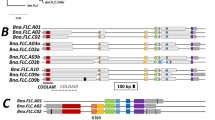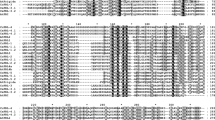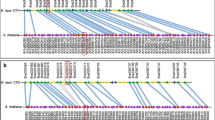Abstract
The repressor FLOWERING LOCUS C (FLC) holds a key position among the genes, which drive Arabidopsis floral transition along the vernalization pathway. The FRIGIDA (FRI) gene activates FLC expression, and the interplay of strong and weak alleles of FLC and FRI in many cases explains the variations in Arabidopsis requirement for cold induction. In annual and biennial life forms of Brassica, the variations in time to flower have been also related to FLC; whereas the place of FRI in the vernalization process has not been sufficiently elucidated. In contrast to Arabidopsis, FRI in Brassica genomes A and C and presumably B is represented by two expressible loci, FRI.a and FRI.b, each of them manifesting genome-specific polymorphisms. FRI.a and FRI.b sequences from diploid species B. rapa (genome A) and B. oleracea (genome C) are conserved (96–99% similarity) in subgenomes A and C of tetraploid species B. carinata (genome BC), B. juncea (genome AB), and B. napus (genome AC). Phylogenetic analysis of FRI sequences in the genus Brassica clearly discerns the lineages A/C and B, while in the family Brassicaceae, two FRI clusters discriminated by such analysis correspond to the lineages I (including the genus Arabidopsis) and II (including the genus Brassica). The origin of two FRI loci is discussed in the context of the Brassicaceae evolution via paleopolyploidy and subsequent genome reorganization.
Similar content being viewed by others
Abbreviations
- FRI :
-
FRIGIDA
- FLC :
-
FLOWERING LOCUS C
- aa:
-
amino acid residues
- Mya:
-
million years ago
- QTL:
-
quantitative trait locus
References
Alonso-Blanco, C., Aart, M.G.M., Bentsink, L., Keurentjes, J.J.B., Reymond, M., Vreugdenhil, D., and Koornneef, M., What has natural variation taught us about plant development, physiology, and adaptation? Plant Cell, 2009, vol. 21, pp. 1877–1896.
Amasino, R., Seasonal and developmental timing of flowering, Plant J., 2010, vol. 61, pp. 1001–1013.
Wilczek, A.M., Burghardt, L.T., Cobb, A.R., Cooper, M.D., Welch, S.M., and Schmitt, J., Genetic and physiological bases for phenological responses to current and predicted climates, Phil. Trans. R. Soc. B., 2010, vol. 365, pp. 3129–3147.
Weigel, D., Natural variation in Arabidopsis: from molecular genetics to ecological genomics, Plant Physiol., 2012, vol. 158, pp. 2–22.
Song, J., Angel, A., Howard, M., and Dean, C., Vernalization — a cold-induced epigenetic switch, J. Cell Sci., 2012, vol. 125, pp. 3723–3731.
Zou, X., Suppanz, I., Raman, H., Hou, J., Wang, J., Long, Y., Jung, C., and Meng, J., Comparative analysis of FLC homologues in Brassicaceae provides insight into their role in the evolution of oilseed rape, PLoS ONE, 2012, vol. 7: e45751.
Xiao, D., Zhao, J., Hou, X.L., Basnet, R.K., Carpio, D.P.D., Zhang, N.W., Bucher, J., Lin, K., Cheng, F., Wang, X.W., and Bonnema, G., The Brassica rapa FLC homologue FLC2 is a key regulator of flowering time, identified through transcriptional coexpression networks, J. Exp. Bot., 2013, vol. 64. pp. 4503–4516.
Wang, N., Qian, W., Suppanz, I., Wei, L., Mao, B., Long, Y., Meng, J., Mueller, A., and Jung, C., Flowering time variation in oilseed rape (Brassica napus L.) is associated with allelic variation in the FRIGIDA homologue BnaA.FRI.A, J. Exp. Bot., 2011, vol. 62, pp. 5641–5658.
Irwin, J.A., Lister, C., Soumpourou, E., Zhang, Y., Howell, E.C., Teakle, G., and Dean, C., Functional alleles of the flowering time regulator FRIGIDA in the Brassica oleracea genome, BMC Plant Biol., 2012, vol. 12, p. 21.
Fadina, O.A., Pankin, A.A., and Khavkin, E.E., Molecular characterization of the flowering time gene FRIGIDA in Brassica genomes A and C, Russ. J. Plant Physiol., 2013, vol. 60, pp. 279–289.
Fadina, O.A., Evolution of gene FRIGIDA in Brassica, Tr. po prikl. botanike, genetike i selektsii (Proc. Applied Botany, Genetics, and Selection), St. Petersburg: VIR, 2013, vol. 173, pp. 39–48.
Risk, J.M., Laurie, R.E., Macknight, R.C., and Day, C.L., FRIGIDA and related proteins have a conserved central domain and family specific N- and C-terminal regions that are functionally important, Plant Mol. Biol., 2010, vol. 73, pp. 493–505.
Tamura, K., Peterson, D., Stecher, G., Nei, M., and Kumar, S., MEGA5: molecular evolutionary genetics analysis using maximum likelihood, evolutionary distance, and maximum parsimony methods, Mol. Biol. Evol., 2011, vol. 28, pp. 2731–2739.
Ostergaard, L. and King, G., Standardized gene nomenclature for the Brassica genus, Plant Methods, 2008, vol. 4, p. 10.
Choi, K., Kim, J., Hwang, H.J., Kim, S., Park, C., Kim, S.Y., and Lee, I., The FRIGIDA complex activates transcription of FLC, a strong flowering repressor in Arabidopsis, by recruiting chromatin modification factors, Plant Cell, 2011, vol. 23, pp. 289–303.
Kemi, U., Niittyvuopio, A., Toivainen, T., Pasanen, A., Quilot-Turion, B., Holm, K., Lagercrantz, U., Savolainen, O., and Kuittinen, H., Role of vernalization and of duplicated FLOWERING LOCUS C in the perennial Arabidopsis lyrata, New Phytol., 2013, vol. 197, pp. 323–335.
Geraldo, N., Bäurle, I., Kidou, S.K., Hu, X., and Dean, C., FRIGIDA delays flowering in Arabidopsis via a co-transcriptional mechanism involving direct interaction with the nuclear cap binding complex, Plant Physiol., 2009, vol. 150, pp. 1611–1618.
Lysak, M.A., Koch, M.A., Pecinka, A., and Schubert, I., Chromosome triplication found across the tribe Brassiceae, Genome Res., 2005, vol. 15, pp. 516–525.
Tang, H., Woodhouse, M.R., Cheng, F., Schnable, J.C., Pedersen, B.S., Conant, G., Wang, X., Freeling, M., and Pires, J.C., Altered patterns of fractionation and exon deletions in Brassica rapa support a two-step model of paleohexaploidy, Genetics, 2012, vol. 190, pp. 1563–1574.
Cheung, F., Trick, M., Drou, N., Lim, Y.P., Park, J.Y., Kwon, S.J., Kim, J.A., Scott, R., Pires, J.C., Paterson, A.H., Town, C., and Bancroft, I., Comparative analysis between homoeologous genome segments of Brassica napus and its progenitor species reveals extensive sequence-level divergence, Plant Cell, 2009, vol. 21, pp. 1912–1928.
Couvreur, T.L.P., Franzke, A., Al-Shehbaz, I.A., Bakke, F.T., Koch, M.A., and Mummenhoff, K., Molecular phylogenetics, temporal diversification, and principles of evolution in the mustard family (Brassicaceae), Mol. Biol. Evol., 2010, vol. 27, pp. 55–71.
Lou, P., Wu, J., Cheng, F., Cressman, L.G., Wang, X., McClung, C.R., Preferential retention of circadian clock genes during diploidization following whole genome triplication in Brassica rapa, Plant Cell, 2012. vol. 24. pp. 2415–2426.
Warwick, S.I. and Sauder, C.A., Phylogeny of tribe Brassiceae (Brassicaceae) based on chloroplast restriction site polymorphisms and nuclear ribosomal internal transcribed spacer and chloroplast trnl intron sequences, Can. J. Bot., 2005, vol. 83, pp. 467–483.
Kuittinen, H., Niittyvuopio, A., Rinne, P., and Savolainen, O., Natural variation in Arabidopsis lyrata vernalization requirement conferred by a FRIGIDA indel polymorphism, Mol. Biol. Evol., 2008, vol. 25, pp. 319–329.
Author information
Authors and Affiliations
Corresponding author
Additional information
Original Russian Text © O.A. Fadina, E.E. Khavkin, 2014, published in Fiziologiya Rastenii, 2014, Vol. 61, No. 3, pp. 334–342.
Rights and permissions
About this article
Cite this article
Fadina, O.A., Khavkin, E.E. The vernalization gene FRIGIDA in cultivated Brassica species. Russ J Plant Physiol 61, 309–317 (2014). https://doi.org/10.1134/S1021443714030030
Received:
Published:
Issue Date:
DOI: https://doi.org/10.1134/S1021443714030030




